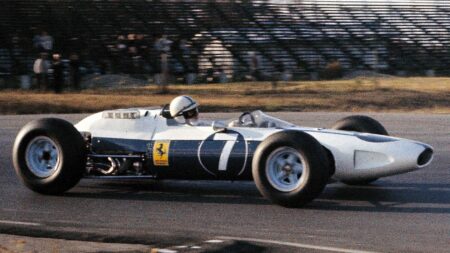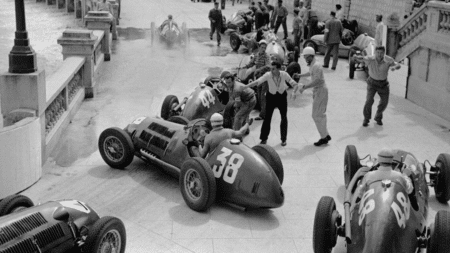It’s gone down as one of the most renowned mano a mano duels in American motor racing history. Parnelli Jones and Mark Donohue battled furiously for Trans-Am supremacy in 1969 and ‘70 with Donohue winning the championship in ‘69 and Jones prevailing by a single point the following year.

The Trans-Am was at its historic height during those years, with large fields featuring factory teams from Ford, Chevrolet, Dodge, Plymouth and American Motors and big names like Jones, Donohue, Dan Gurney, Peter Revson and George Follmer. But all the money from Detroit resulted in a rapid escalation of technology and creative rule-bending and by the mid-70s the factories and star drivers were gone and the Trans-Am became only a shadow of its once-great self.
Jones was the archetypal Indycar superstar of the ‘60s, a tough, flinty-eyed character who made his name on California’s dirt tracks racing jalopies and sprint cars and was the man to beat at Indianapolis most years from 1961-67. Parnelli’s calling card was his aggressive, take-no-prisoners driving style and a reputation for settling arguments with his fists. In contrast, Donohue was a college-educated east coast road racer who was known for his smooth driving and engineering ability.

In 1966 Donohue was hired by Roger Penske to run Penske’s new racing team. In addition to being Penske’s number one driver Donohue was the team manager and chief engineer and he showed his stuff by winning the 1966 United States Road Racing Championship aboard Penske’s Lola T70 Can-Am car. The following year they moved into the Trans-Am series with factory-backed Chevy Camaros and Donohue dominated the series in 1968, winning nine of 12 races.
Jones had retired from Indycars after dominating but ultimately retiring from the 1967 Indy 500 in Andy Granatelli’s STP turbine car. But he wanted to continue racing cars with roofs and later in ’67 he run a handful of Trans-Am races in driving a Mercury Cougar for top NASCAR team owner Bud Moore. Parnelli didn’t compete in the Trans-Am in ‘68 but after Donohue swept that year’s series Ford decided to put its full support behind Moore for 1969 and ‘70. Parnelli and George Follmer were hired to drive a pair of Mustangs, thus initiating an epic battle between Jones and Donohue.
Tyre problems prevented Jones from challenging Donohue more seriously in ‘69 as Donohue won six of the last seven races and took his second straight Trans-Am title. Penske and Donohue switched to racing Javelins for American Motors in 1970 and the duel reached new heights of fender-bashing as Jones came through to win the championship for Ford and Moore. Jones and Follmer drove the classic ‘grabber orange’ Mustangs in 1970 with Jones winning five races and the Trans-Am title while Follmer won one race and finished third in points behind Donohue.

But the Jones-Donohue duel came to an abrupt end that winter when each of Ford, Chevrolet, Dodge and Plymouth pulled out of the Trans-Am. Donohue and Penske were left to completely dominate the ‘71 series with their Javelins while Jones went on his way, twice winning the Baja 1000 off-road race and setting a Baja record that remains unbroken to this day.
“If you took a hard look at every major series in the country in 1970, you’d have thought the Trans-Am was the healthiest,” Jones writes in his book As a matter of fact, I am Parnelli Jones. “Just about all the manufacturers were involved, and they were lined up with really strong teams and drivers.
“Ford had our Bud Moore cars, which were officially named Boss 302 Mustangs. Penske had brought in American Motors and their Javelins with Donohue and Peter Revson for drivers. Chevrolet had Jim Hall’s Camaro team with Ed Leslie, Vic Elford and Hall himself driving. Jerry Titus seemed to be getting some factory help with his Pontiac Firebirds. Plymouth had gotten Gurney away from Ford and was running Dan alongside Swede Savage in Plymouth Barracudas out of Gurney’s All American Racers shop. Dodge had Sam Posey in a Challenger. And there were a bunch of privateers that got parts and help from the big teams or from the manufacturers and some of them were very competitive.

“The whole damn series was war. That’s the truth. Before long the factories were acid-dipping the steel bodies to lighten them, laying the windshields back for better aerodynamics and modifying anything else they thought they could get away with. And they got away with a lot because the SCCA technical inspectors never saw cheating that sophisticated in their lives. They were no match for all those Detroit engineers, not to mention guys like Donohue, Penske, Gurney, Bud Moore and me.
“When I came into Trans-Am back in the Cougar days, I raced hard but I had fun. By 1970 the fun had stopped. I still loved it, but it had gotten much more serious. It was all-out racing, a real knockdown battle.
“Our main competition, always, was Penske and Donohue. At first that was because we had the Ford team and they were the Chevy guys, but when they switched to Javelins they were still the guys we wanted to beat.
“Even back then, Roger was dedicated to winning, and Mark, in addition to being a good driver was an engineer himself; he knew exactly what he wanted and he built it into those cars. I had a great deal of respect for Donohue.
“The only problem I ever had with Mark was that he was the kind of guy who complained whether he won or lost. For example, in 1969, when everyone knew he and Roger were supported by Chevrolet, Mark would win a race and still gripe about how hard it was to race against Ford and its big money. It’s one thing to lose a race and cry, but Mark would win and cry. Man, that bothered me.
“I think – no, I know – that I made Mark Donohue a tougher race driver. I saw him improve throughout the whole period we spent in Trans-Am. Mark had the talent all along, no question, but when he raised his level of aggression we saw how good he really was. He ended up winning just about everywhere he went, including Indianapolis.

“I have fond memories of the Trans-Am series. And I loved the racing itself. I had some terrific races with Donohue, Gurney and even Follmer, my team-mate. We put on some great shows, I think, and we raced really hard.”
Today, the Trans-Am cars of that era, proudly turned out in the colours and race numbers of the likes of Jones, Donohue, Gurney and Follmer, are among the most popular for both American historic racing competitors and fans. And for good reason. They make a lot of power and noise. They slither and slide, and as Parnelli says, they put on a great show.










